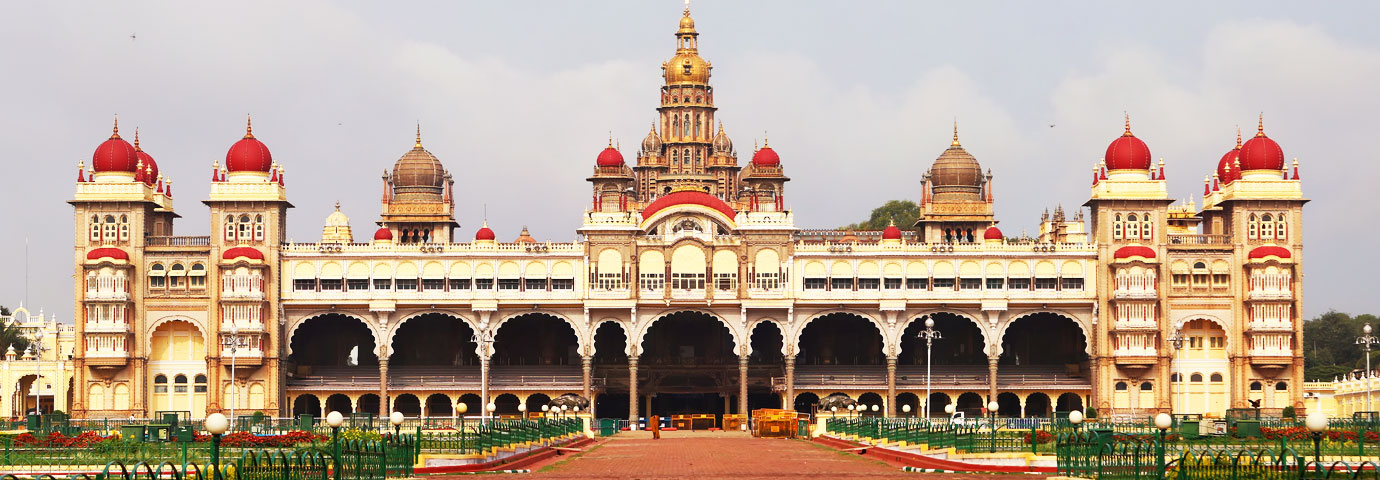
Opening Time- The palace remains open all days of the week from 10 A.M to 5:30 P.M
Light and Sound Show timings: The Light and Sound show is arranged every day except on Sundays, national holidays and state holidays. Timing for the same is 7:00 P.M to 7:40 P.M
Tickets are available at the southern gate of Mysore Palace (Amba Vilas Palace)
Location- Sayyaji Rao Rd, Mysuru, Karnataka 570001
Mysore is a year-round destination and anytime is best time to visit Mysore Palace. However, we strongly recommend visiting Mysore Palace during its nation-wide popular Dasara (Dussehra Festival) celebration that falls in September/October/November.
Amba Vilas Palace, or Mysore Palace, is the most popular attraction of the city of Mysore (also called The City of Palaces) in Karnataka State. This regal palace marks architectural brilliance and this becomes apparent right after the first glimpse. The palace is official residence of Mysore’s royal family, Wodeyars; who ruled over Mysore between 1350 and 1950. Most parts of the structure are under the control of Karnataka State Government. After Taj Mahal of Agra, Amba Vilas Palace is the most visited tourist spot of India.
The palace was built in 1912 to replace the original palace that made of wood in 1897. The original palace caught fire during royal wedding of princes. Today, it is counted as one among the largest and grandest forts of India.
Architectural style of Amba Vilas Palace is Indo-Saracenic Revival architecture.
The palace is built by creating a fusion of Gothic, Hindu, Muslim and Rajput styles of architectures. At the entrance, an arched gateway welcomes the visitors. It is adorned with emblem and coat of arms of Mysore Kingdom and Sanskrit verse (नबिभॆतिकदाचन- motto of the kingdom which means Never Terrified). Moving further, there are three other entranceways- The West Entrance (opened usually in the festival of Dussehra), The East Entrance (This is the front gate that is only open for VVIPs and during the festival of Dussehra) and South Entrance (which is the main public entrance).
The royal edifice has three floors and is mainly built of fine grey granite and deep pink marbles (for dome). Its façade is decorated with arches, supported by ornate pillars. The central arch has a sculpture of the Hindu Goddess of Wealth Gajalakshmi with her elephant. It faces towards Chamundi Hills because the erstwhile rulers were staunch devotees of Goddess Chamundi.
There are various temples in the palace complex. The oldest of all temples date back to 14th century and the newest to 1953. Some popular temples near the palace are Someshvara Temple, Lakshmiramana Temple, Sri Bhuvaneshwari Temple, Sri Gayatri Temple, Sri Trineshwara Temple and Shwetha Varahaswamy Temple.
Mysore’s Dasara (Dussehra) festival celebrations are renowned all around the country. Undoubtedly, this is the best time to visit Mysore and behold the beauty of Amba Vilas Palace. This festival is the conclusion of Navratri Festival and celebrates the victory of good upon evil.
On this day the grand processions are held. An idol of Goddess Chamundeshwari is installed on a golden mantapa and then the mantapa is placed at the top of a beautifully decorated elephant. Royal couple and other invitees worship the idol of the goddess and then it is taken further for the parade.
In the procession, dance groups and musicians move with decorated elephants, camels and horses. The procession gets started from the Amba Vilas Palace. The palace on this day is illuminated with more than 96000 lights for a period of two months. About one crore Indian rupees are spent every year for the maintenance of these lights alone. At the front of the beautiful Mysore Palace, State Government of Karnataka arranges cultural programs. The artists who partake in this program come from different parts of India.
This was the room used as hall for special guests of the king. The entry to this room consists of a rosewood doorway with inlaid ivory that opens a shrine dedicated to Lord Ganesha. Stained glass ceilings, glided columns, chandeliers decorated with floral motifs and decorative steel grills are ornately adapted for prettification.
Kalyana Mantapa means Marriage Hall wrought in Glasgow, Scotland. The pavilion of the hall is octagonal decorated with multi-color stained glass having peacock motifs arranged geometrically. Interesting oil paintings inside the hall illustrate the royal procession of Dasara during yesteryear.
As the name suggests this hall exhibits a collection of dolls. These traditional dolls belong to nineteenth and early twentieth century. Other than the dolls, a collection of Indian and European sculpture and ceremonial objects are placed in the hall. Another highlight of this hall is the wooden elephant howdah (a frame that carries passengers on the elephant) decorated with not less than 84 km of pure gold.
Subscribe Our Newsletter for get latest updates
Follow us: